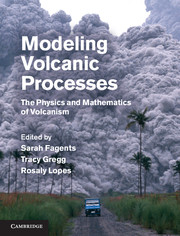Book contents
- Frontmatter
- Contents
- Contributors
- Chapter 1 Introduction
- Chapter 2 Magma chamber dynamics and thermodynamics
- Chapter 3 The dynamics of dike propagation
- Chapter 4 Dynamics of magma ascent in the volcanic conduit
- Chapter 5 Lava flows
- Chapter 6 Unsteady explosive activity
- Chapter 7 Unsteady explosive activity
- Chapter 8 Sustained explosive activity
- Chapter 9 Modeling tephra sedimentation from volcanic plumes
- Chapter 10 Pyroclastic density currents
- Chapter 11 Magma–water interactions
- Chapter 12 Deep-sea eruptions
- Chapter 13 Volcano–ice interactions
- Chapter 14 Modeling lahar behavior and hazards
- Chapter 15 Introduction to quantitative volcano seismology
- Chapter 16 Volcano acoustics
- Chapter 17 Planetary volcanism
- Index
- Plate section
- References
Chapter 10 - Pyroclastic density currents
Published online by Cambridge University Press: 05 March 2013
- Frontmatter
- Contents
- Contributors
- Chapter 1 Introduction
- Chapter 2 Magma chamber dynamics and thermodynamics
- Chapter 3 The dynamics of dike propagation
- Chapter 4 Dynamics of magma ascent in the volcanic conduit
- Chapter 5 Lava flows
- Chapter 6 Unsteady explosive activity
- Chapter 7 Unsteady explosive activity
- Chapter 8 Sustained explosive activity
- Chapter 9 Modeling tephra sedimentation from volcanic plumes
- Chapter 10 Pyroclastic density currents
- Chapter 11 Magma–water interactions
- Chapter 12 Deep-sea eruptions
- Chapter 13 Volcano–ice interactions
- Chapter 14 Modeling lahar behavior and hazards
- Chapter 15 Introduction to quantitative volcano seismology
- Chapter 16 Volcano acoustics
- Chapter 17 Planetary volcanism
- Index
- Plate section
- References
Summary
Overview
This chapter summarizes the principal experimental and theoretical approaches used to investigate the physics of pyroclastic density currents (PDCs), which are gravity-driven hot gas–particle mixtures commonly generated during explosive volcanic eruptions. PDC behavior ranges from pyroclastic surges, which are dilute turbulent suspensions, to pyroclastic flows, which are dense (fluidized) granular avalanches. Most PDCs consist of a coupled basal flow and an overriding surge, which renders their physics particularly complex. Experiments and phenomenological theory have been used to characterize the propagation and deposition mechanisms of PDCs. Most work has used turbulent gravity currents as an analogue to dilute PDCs and has provided fundamental insight into propagation and deposition dynamics and mixing with their surroundings. Dense PDCs have been investigated as granular and fluidized flows, and these studies have provided insight into deposit levée-channel morphology typical of coarse-grained flows, shown that fines-rich flows may behave as inertial fluid currents, and suggested that deposits of PDCs may form by aggradation. Numerical formulations ranging from continuum depth-averaged to discrete element models have been used to simulate PDC emplacement on real topographies and are fundamental in the context of volcanic hazard assessment and mitigation.
Principal characteristics of pyroclastic density currents
Pyroclastic density currents (PDCs) are common features of explosive volcanic eruptions. They are generated from the gravitational collapse of lava domes (Chapter 7) or eruptive columns (Chapter 8), by lateral explosions in the case of hydromagmatic activity (Chapter 11) or sudden decompression of a magma body (Fig. 10.1), as well as during the formation of collapse calderas. PDCs are hot (up to ~600–800°C), gravity-driven, gas–particle mixtures within which the interstitial fluid may control the flow dynamics. The pyroclasts result from magma fragmentation and their granulometry commonly ranges from micron-sized ash to centimeter-sized lapilli and sometimes meter-sized blocks. PDCs have typical volumes of ~104–108 m3, though their accumulation during an eruptive event can form deposits > 103 km3.
Information
- Type
- Chapter
- Information
- Modeling Volcanic ProcessesThe Physics and Mathematics of Volcanism, pp. 203 - 229Publisher: Cambridge University PressPrint publication year: 2013
References
Accessibility standard: Unknown
Why this information is here
This section outlines the accessibility features of this content - including support for screen readers, full keyboard navigation and high-contrast display options. This may not be relevant for you.Accessibility Information
- 18
- Cited by
